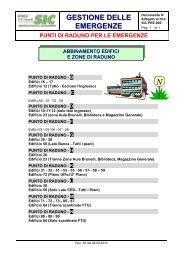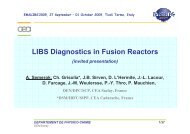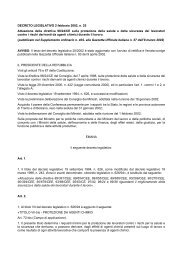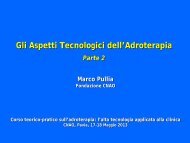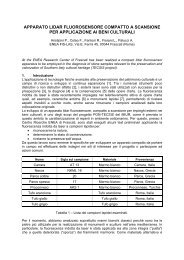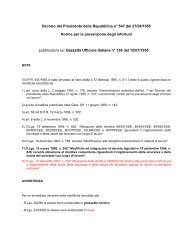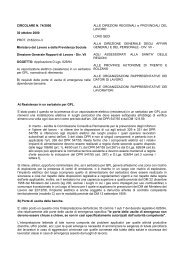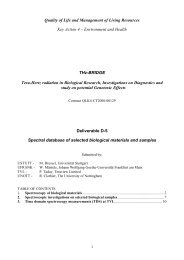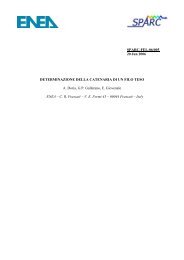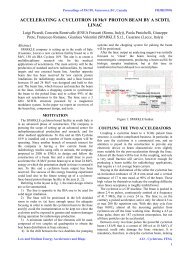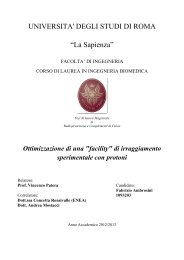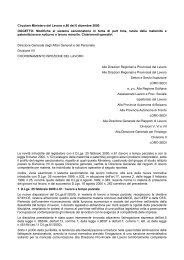Theory, Design and Tests on a Prototype Module of a Compact ...
Theory, Design and Tests on a Prototype Module of a Compact ...
Theory, Design and Tests on a Prototype Module of a Compact ...
You also want an ePaper? Increase the reach of your titles
YUMPU automatically turns print PDFs into web optimized ePapers that Google loves.
92 5. RADIOFREQUENCY MEASUREMENT<br />
In all the cases it is clear that the differences respect the reference<br />
case <strong>of</strong> figure 5.21 were acceptable.<br />
In figure 5.23 is shown the effect <strong>of</strong> a perturbati<strong>on</strong> <strong>on</strong> the CCs which<br />
are nearest to the bridge coupler. From first bead pulling, which are<br />
the reference, it is apparent that the level <strong>of</strong> field in the last AC <strong>of</strong><br />
tank #1 is high respect to the mean <strong>of</strong> the tank, the theory says that<br />
if the nearest CC is changed the level in the following AC (respect to<br />
the feeder) changes also.<br />
Figure 5.23. The effect <strong>of</strong> local perturbati<strong>on</strong>s in the<br />
CCs at the end <strong>of</strong> a tank.<br />
7. Measurement <strong>of</strong> the coupling between the module <str<strong>on</strong>g>and</str<strong>on</strong>g><br />
the waveguide through an iris<br />
In this paragraph the procedure to measure the coupling between<br />
the power waveguide <str<strong>on</strong>g>and</str<strong>on</strong>g> the LIBO module is explained [34]. The procedure<br />
is exportable to other cases, as the case <strong>of</strong> multi-cells structures<br />
feeded by <strong>on</strong>e cavity through an iris.<br />
First, we introduce some basic c<strong>on</strong>cepts <str<strong>on</strong>g>and</str<strong>on</strong>g> the equivalent circuit,<br />
then we introduce some figures <strong>of</strong> merit to evaluate the correct matching,<br />
next we explain the RF procedure to get the numerical data with<br />
the help <strong>of</strong> a Network Analyzer; last we introduce a numeric MATLAB<br />
program that, starting from the measurement data, is able to deduce<br />
the desired figures <strong>of</strong> merit, <str<strong>on</strong>g>and</str<strong>on</strong>g> finally we comment the results.<br />
7.1. The equivalent circuit for <strong>on</strong>e cavity. In the previous<br />
chapters we already introduced the c<strong>on</strong>cept <strong>of</strong> equivalent lumped elements<br />
circuit for res<strong>on</strong>ant cavities. Of course, we know that the equivalent<br />
descripti<strong>on</strong> is rather difficult because, as in wave-guides, the ordinary<br />
c<strong>on</strong>cept <strong>of</strong> voltage <str<strong>on</strong>g>and</str<strong>on</strong>g> current does not play its usual role.<br />
ω 2 0 = 1/LC, Q0 = ω0L<br />
2 (ω0L)<br />
, R0 = ω0LQ0 =<br />
Rs<br />
Rs<br />
(5.14)<br />
The three quantities defined by these relati<strong>on</strong>s can be measured experimentally,<br />
as it is shown in the previous secti<strong>on</strong>s, <str<strong>on</strong>g>and</str<strong>on</strong>g> can be used to<br />
establish the lumped elements<br />
L = R0<br />
, C =<br />
ω0Q0<br />
Q0<br />
, Rs =<br />
ω0R0<br />
R0<br />
Q2 . (5.15)<br />
0



